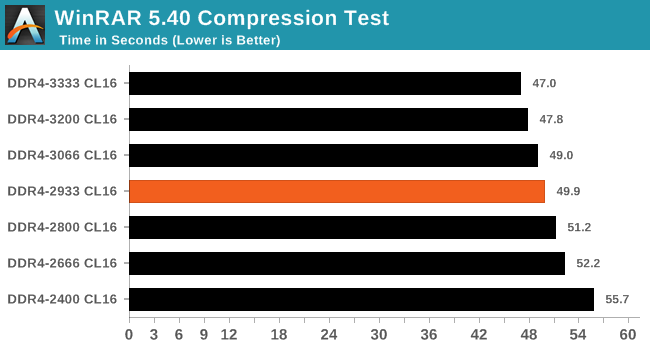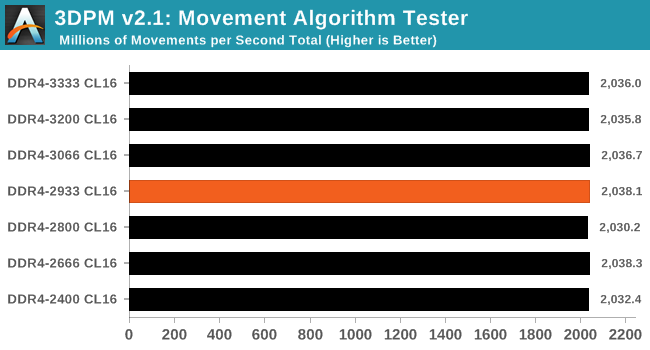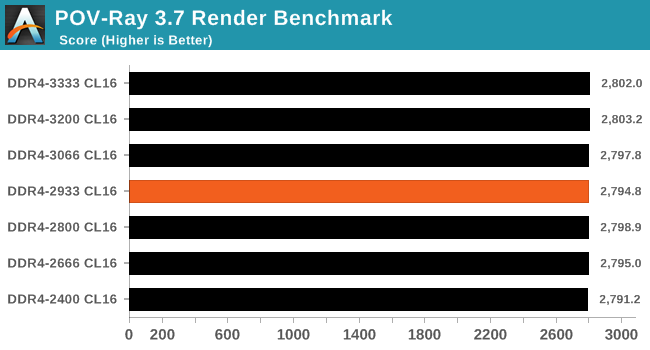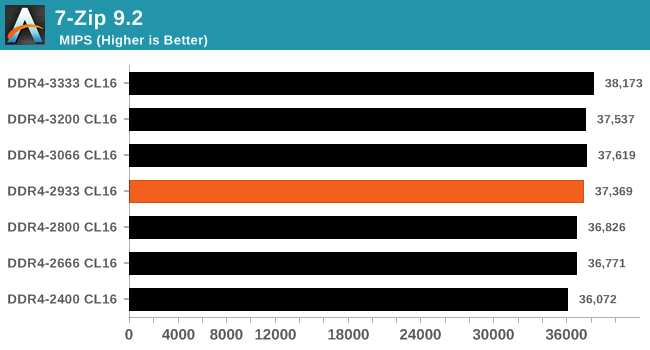Memory Scaling on Ryzen 7 with Team Group's Night Hawk RGB
by Ian Cutress & Gavin Bonshor on September 27, 2017 11:05 AM ESTCPU Performance, Short Form
For our quick reviews, we use our short form testing method.
Video Conversion – Handbrake v1.0.2: link
Video transcoding (both encode and decode) is a hot topic in performance metrics as more and more content is being created. First consideration is the standard in which the video is encoded, which can be lossless or lossy, trade performance for file-size, trade quality for file-size, or all of the above can increase encoding rates to help accelerate decoding rates. Alongside Google's favorite codec, VP9, there are two others that are taking hold: H264, the older codec, is practically everywhere and is designed to be optimized for 1080p video, and HEVC (or H265) that is aimed to provide the same quality as H264 but at a lower file-size (or better quality for the same size). HEVC is important as 4K is streamed over the air, meaning less bits need to be transferred for the same quality content.
Handbrake is a favored tool for transcoding, and so our test regime takes care of three areas.
Low Quality/Resolution H264: Here we transcode a 640x266 H264 rip of a 2 hour film, and change the encoding from Main profile to High profile, using the very-fast preset.

High Quality/Resolution H264: A similar test, but this time we take a ten-minute double 4K (3840x4320) file running at 60 Hz and transcode from Main to High, using the very-fast preset.

HEVC Test: Using the same video in HQ, we change the resolution and codec of the original video from 4K60 in H264 into 4K60 HEVC.

The biggest gains in Handbrake came in the HQ test where we gained up to an extra +21% in performance for DDR4-3333 over DDR4-2400. The fact that we don't see the same gains in the HEVC test is likely down to the algorithm.
Compression – WinRAR 5.40: link
For the 2017 test suite, we move to the latest version of WinRAR in our compression test. WinRAR in some quarters is more user friendly that 7-Zip, hence its inclusion. Rather than use a benchmark mode as we did with 7-Zip, here we take a set of files representative of a generic stack (33 video files in 1.37 GB, 2834 smaller website files in 370 folders in 150 MB) of compressible and incompressible formats. The results shown are the time taken to encode the file. Due to DRAM caching, we run the test 10 times and take the average of the last five runs when the benchmark is in a steady state.

Like with Handbrake, the system seemed to scale pretty well in WinRAR with a ~16% performance gain going from DDR4-2400 to DDR4-3333.
3D Movement Algorithm Test v2.1
This is the latest version of the self-penned 3DPM benchmark. The goal of 3DPM is to simulate semi-optimized scientific algorithms taken directly from my doctorate thesis. Version 2.1 improves over 2.0 by passing the main particle structs by reference rather than by value, and decreasing the amount of double->float->double recasts the compiler was adding in. It affords a ~25% speed-up over v2.0, which means new data.

Although more of a raw CPU benchmark, it shows here that memory isn’t a massive factor, as regardless of memory speed, we encountered marginal performance gains.
POV-Ray 3.7: link
Another regular benchmark in most suites, POV-Ray is another ray-tracer but has been around for many years. It just so happens that during the run up to AMD's Ryzen launch, the code base started to get active again with developers making changes to the code and pushing out updates. Our version and benchmarking started just before that was happening, but given time we will see where the POV-Ray code ends up and adjust in due course.

POV-Ray might be a fruitful benchmark for testing memory stability, but our performance variation between memory speeds was within the margin of error.
7-Zip 9.2: link
One of the freeware compression tools that offers good scaling performance between processors is 7-Zip. It runs under an open-source licence, is fast, and easy to use tool for power users. We run the benchmark mode via the command line for four loops and take the output score.

Some compression tools can be susceptible to memory performance and it shows in our results such as WinRAR. 7-zip has a small performance boost as we rise up through the stack, although the differences above DDR4-2666 are fairly minimal.










65 Comments
View All Comments
lyssword - Friday, September 29, 2017 - link
Seems these tests are GPU-limited (gtx 980 is about 1060-6gb) thus may not show true gains if you had something like 1080ti, and also not the most demanding cpu-wise except maybe warhammer and ashesAlexvrb - Sunday, October 1, 2017 - link
Some of the regressions don't make sense. Did you double-check timings at every frequency setting, perhaps also with Ryzen Master software (the newer versions don't require HPET either IIRC)? I've read on a couple of forums where above certain frequencies, the BIOS would bump some timings regardless of what you selected. Not sure if that only affects certain AGESA/BIOS revisions and if it was only certain board manufacturers (bug) or widespread. That could reduce/reverse gains made by increasing frequency, depending on the software.Still, there is definitely evidence that raising memory frequency enables decent performance scaling, for situations where the IF gets hammered.
ajlueke - Friday, October 6, 2017 - link
As others have mentioned here, it is often extremely useful to employ modern game benchmarks that will report CPU results regardless of GPU bottlenecks. Case in point, I ran a similar test to this back in June utilizing the Gears of War 4 benchmark. I chose it primarily because the benchmark with display CPU (game) and CPU (render) fps regardless of GPU frames generated.https://community.amd.com/servlet/JiveServlet/down...
At least in Gears of War 4, the memory scaling on the CPU style was substantial. But to be fair, I was GPU bound in all of these tests, so my observed fps would have been identical every time.
https://community.amd.com/servlet/JiveServlet/down...
Really curious if my results would be replicated in Gears 4 with the hardware in this article? That would be great to see.
farmergann - Wednesday, October 11, 2017 - link
For gaming, wouldn't it be more illuminating to look at frame-time variance and CPU induced minimums to get a better idea of the true benefit of the faster ram?JasonMZW20 - Tuesday, November 7, 2017 - link
I'd like to see some tests where lower subtimings were used on say 3066 and 3200, versus higher subtimings at the same speeds (more speeds would be nice, but it'd take too much time). I'd think gaming is more affected by latency, since they're computing and transferring datasets immediately.I run my Corsair 3200 Vengeance kit (Hynix ICs) at 3066 using 14-15-15-34-54-1T at 1.44v. The higher voltage is to account for tighter subtimings elsewhere, but I've tested just 14-15-15-34-54-1T (auto timings for the rest) in Memtest86 at 1.40v and it threw 0 errors after about 12 hours. Geardown mode disabled.